eco mode Hyundai Ioniq Plug-in Hybrid 2020 Workshop Manual
[x] Cancel search | Manufacturer: HYUNDAI, Model Year: 2020, Model line: Ioniq Plug-in Hybrid, Model: Hyundai Ioniq Plug-in Hybrid 2020Pages: 635, PDF Size: 52.13 MB
Page 452 of 635
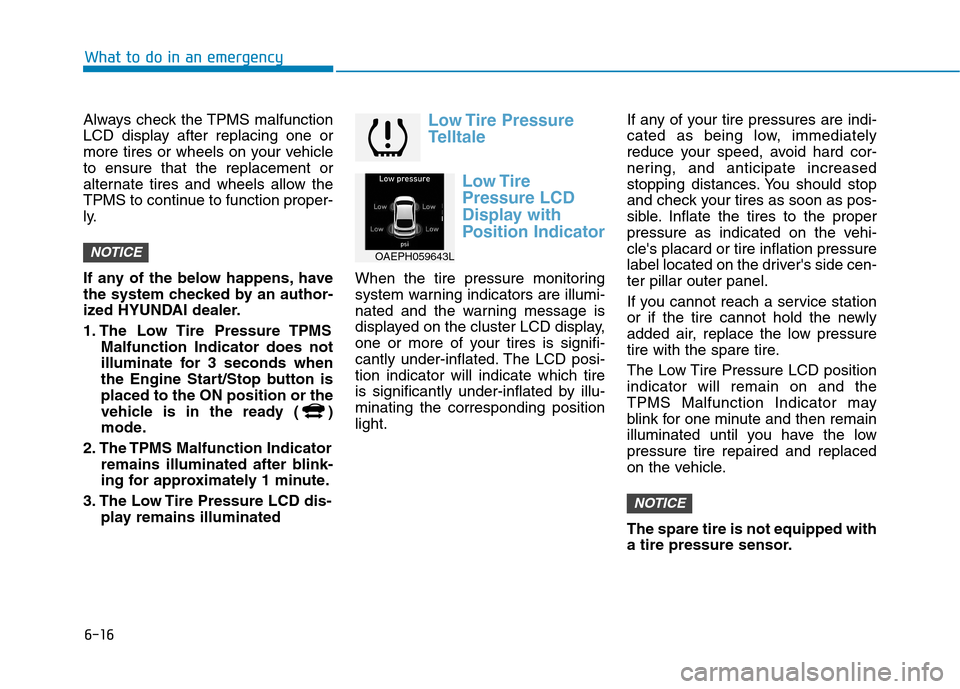
6-16
What to do in an emergency
Always check the TPMS malfunction
LCD display after replacing one or
more tires or wheels on your vehicle
to ensure that the replacement or
alternate tires and wheels allow the
TPMS to continue to function proper-
ly.
If any of the below happens, have
the system checked by an author-
ized HYUNDAI dealer.
1. The Low Tire Pressure TPMS
Malfunction Indicator does not
illuminate for 3 seconds when
the Engine Start/Stop button is
placed to the ON position or the
vehicle is in the ready ( )
mode.
2. The TPMS Malfunction Indicator
remains illuminated after blink-
ing for approximately 1 minute.
3. The Low Tire Pressure LCD dis-
play remains illuminated
Low Tire Pressure
Telltale
Low Tire
Pressure LCD
Display with
Position Indicator
When the tire pressure monitoring
system warning indicators are illumi-
nated and the warning message is
displayed on the cluster LCD display,
one or more of your tires is signifi-
cantly under-inflated. The LCD posi-
tion indicator will indicate which tire
is significantly under-inflated by illu-
minating the corresponding position
light.If any of your tire pressures are indi-
cated as being low, immediately
reduce your speed, avoid hard cor-
nering, and anticipate increased
stopping distances. You should stop
and check your tires as soon as pos-
sible. Inflate the tires to the proper
pressure as indicated on the vehi-
cle's placard or tire inflation pressure
label located on the driver's side cen-
ter pillar outer panel.
If you cannot reach a service station
or if the tire cannot hold the newly
added air, replace the low pressure
tire with the spare tire.
The Low Tire Pressure LCD position
indicator will remain on and the
TPMS Malfunction Indicator may
blink for one minute and then remain
illuminated until you have the low
pressure tire repaired and replaced
on the vehicle.
The spare tire is not equipped with
a tire pressure sensor.
NOTICE
NOTICEOAEPH059643L
Page 527 of 635
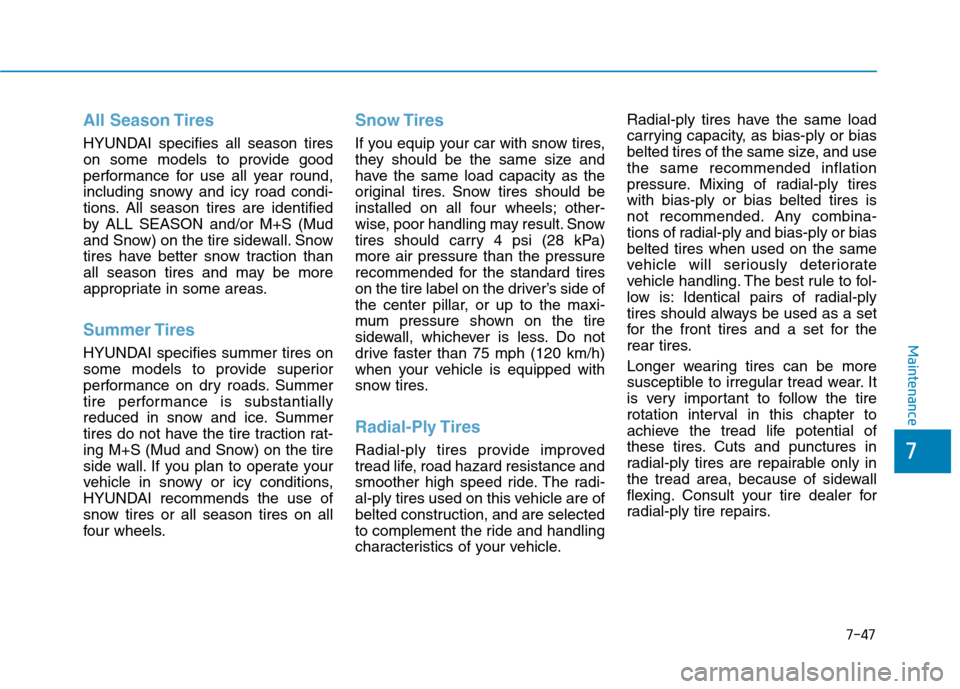
7-47
7
Maintenance
All Season Tires
HYUNDAI specifies all season tires
on some models to provide good
performance for use all year round,
including snowy and icy road condi-
tions. All season tires are identified
by ALL SEASON and/or M+S (Mud
and Snow) on the tire sidewall. Snow
tires have better snow traction than
all season tires and may be more
appropriate in some areas.
Summer Tires
HYUNDAI specifies summer tires on
some models to provide superior
performance on dry roads. Summer
tire performance is substantially
reduced in snow and ice. Summer
tires do not have the tire traction rat-
ing M+S (Mud and Snow) on the tire
side wall. If you plan to operate your
vehicle in snowy or icy conditions,
HYUNDAI recommends the use of
snow tires or all season tires on all
four wheels.
Snow Tires
If you equip your car with snow tires,
they should be the same size and
have the same load capacity as the
original tires. Snow tires should be
installed on all four wheels; other-
wise, poor handling may result. Snow
tires should carry 4 psi (28 kPa)
more air pressure than the pressure
recommended for the standard tires
on the tire label on the driver’s side of
the center pillar, or up to the maxi-
mum pressure shown on the tire
sidewall, whichever is less. Do not
drive faster than 75 mph (120 km/h)
when your vehicle is equipped with
snow tires.
Radial-Ply Tires
Radial-ply tires provide improved
tread life, road hazard resistance and
smoother high speed ride. The radi-
al-ply tires used on this vehicle are of
belted construction, and are selected
to complement the ride and handling
characteristics of your vehicle.Radial-ply tires have the same load
carrying capacity, as bias-ply or bias
belted tires of the same size, and use
the same recommended inflation
pressure. Mixing of radial-ply tires
with bias-ply or bias belted tires is
not recommended. Any combina-
tions of radial-ply and bias-ply or bias
belted tires when used on the same
vehicle will seriously deteriorate
vehicle handling. The best rule to fol-
low is: Identical pairs of radial-ply
tires should always be used as a set
for the front tires and a set for the
rear tires.
Longer wearing tires can be more
susceptible to irregular tread wear. It
is very important to follow the tire
rotation interval in this chapter to
achieve the tread life potential of
these tires. Cuts and punctures in
radial-ply tires are repairable only in
the tread area, because of sidewall
flexing. Consult your tire dealer for
radial-ply tire repairs.
Page 574 of 635
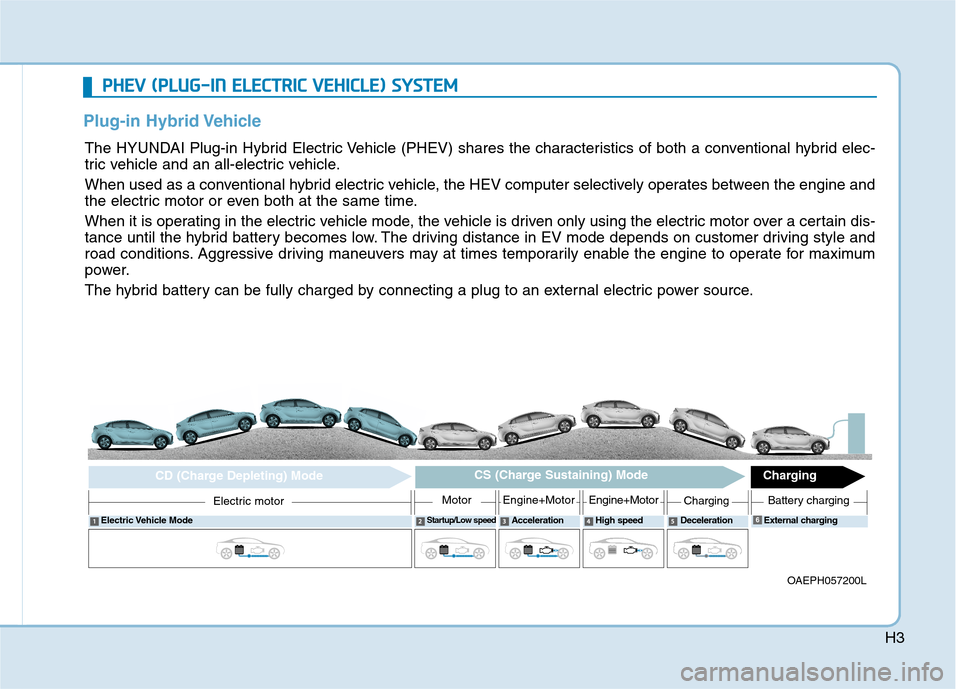
H3
P PH
HE
EV
V
(
(P
PL
LU
UG
G-
-I
IN
N
E
EL
LE
EC
CT
TR
RI
IC
C
V
VE
EH
HI
IC
CL
LE
E)
)
S
SY
YS
ST
TE
EM
M
Plug-in Hybrid Vehicle
The HYUNDAI Plug-in Hybrid Electric Vehicle (PHEV) shares the characteristics of both a conventional hybrid elec-
tric vehicle and an all-electric vehicle.
When used as a conventional hybrid electric vehicle, the HEV computer selectively operates between the engine and
the electric motor or even both at the same time.
When it is operating in the electric vehicle mode, the vehicle is driven only using the electric motor over a certain dis-
tance until the hybrid battery becomes low. The driving distance in EV mode depends on customer driving style and
road conditions. Aggressive driving maneuvers may at times temporarily enable the engine to operate for maximum
power.
The hybrid battery can be fully charged by connecting a plug to an external electric power source.
OAEPH057200L
Electric Vehicle ModeStartup/Low speedAcceleration High speed Deceleration External charging
Electric motor
CD (Charge Depleting) ModeCS (Charge Sustaining) Mode
Charging
MotorEngine+MotorEngine+MotorChargingBattery charging
6
Page 582 of 635
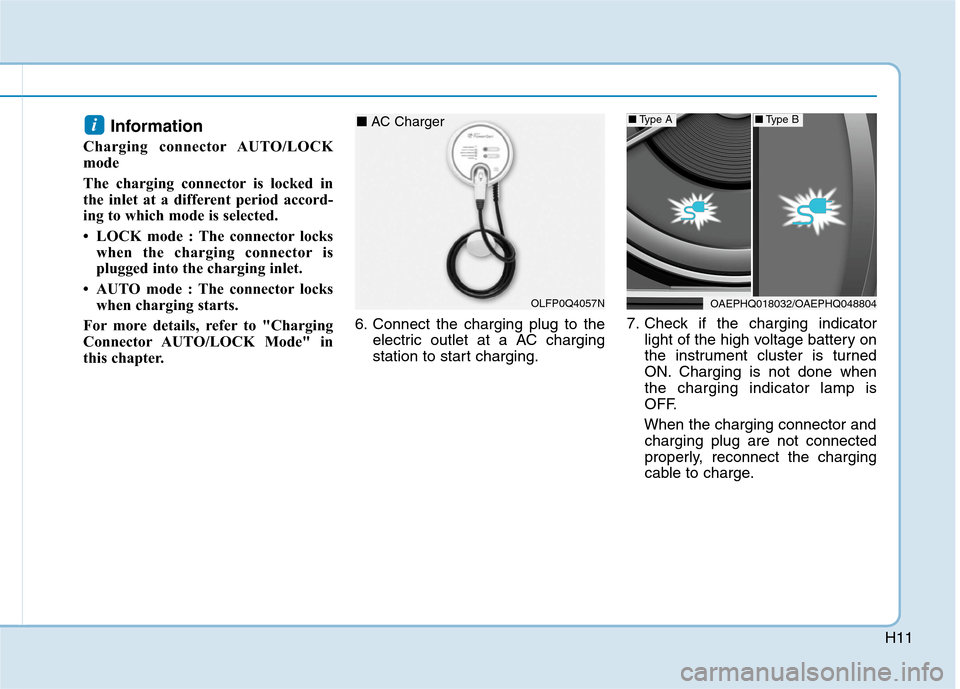
H11
Information
Charging connector AUTO/LOCK
mode
The charging connector is locked in
the inlet at a different period accord-
ing to which mode is selected.
• LOCK mode : The connector locks
when the charging connector is
plugged into the charging inlet.
• AUTO mode : The connector locks
when charging starts.
For more details, refer to "Charging
Connector AUTO/LOCK Mode" in
this chapter.6. Connect the charging plug to the
electric outlet at a AC charging
station to start charging.7. Check if the charging indicator
light of the high voltage battery on
the instrument cluster is turned
ON. Charging is not done when
the charging indicator lamp is
OFF.
When the charging connector and
charging plug are not connected
properly, reconnect the charging
cable to charge.
i
OLFP0Q4057N
■ AC Charger
OAEPHQ018032/OAEPHQ048804
■Type A■Type B
Page 590 of 635
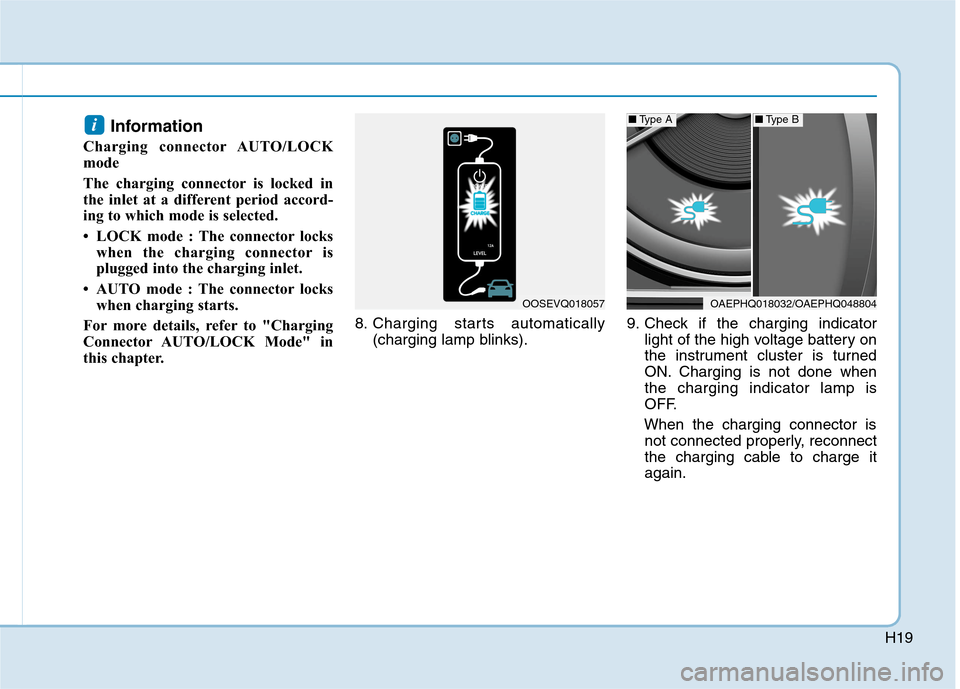
H19
Information
Charging connector AUTO/LOCK
mode
The charging connector is locked in
the inlet at a different period accord-
ing to which mode is selected.
• LOCK mode : The connector locks
when the charging connector is
plugged into the charging inlet.
• AUTO mode : The connector locks
when charging starts.
For more details, refer to "Charging
Connector AUTO/LOCK Mode" in
this chapter.8. Charging starts automatically
(charging lamp blinks).9. Check if the charging indicator
light of the high voltage battery on
the instrument cluster is turned
ON. Charging is not done when
the charging indicator lamp is
OFF.
When the charging connector is
not connected properly, reconnect
the charging cable to charge it
again.
i
OOSEVQ018057OAEPHQ018032/OAEPHQ048804
■Type A■Type B
Page 599 of 635
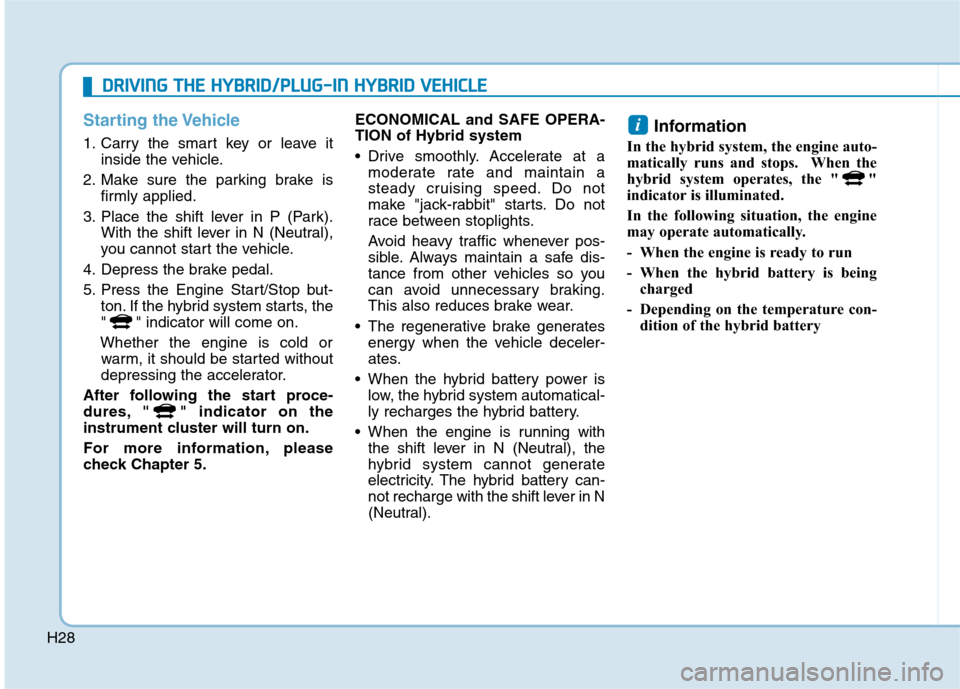
H28
Starting the Vehicle
1. Carry the smart key or leave it
inside the vehicle.
2. Make sure the parking brake is
firmly applied.
3. Place the shift lever in P (Park).
With the shift lever in N (Neutral),
you cannot start the vehicle.
4. Depress the brake pedal.
5. Press the Engine Start/Stop but-
ton. If the hybrid system starts, the
" " indicator will come on.
Whether the engine is cold or
warm, it should be started without
depressing the accelerator.
After following the start proce-
dures, " " indicator on the
instrument cluster will turn on.
For more information, please
check Chapter 5.ECONOMICAL and SAFE OPERA-
TION of Hybrid system
Drive smoothly. Accelerate at a
moderate rate and maintain a
steady cruising speed. Do not
make "jack-rabbit" starts. Do not
race between stoplights.
Avoid heavy traffic whenever pos-
sible. Always maintain a safe dis-
tance from other vehicles so you
can avoid unnecessary braking.
This also reduces brake wear.
The regenerative brake generates
energy when the vehicle deceler-
ates.
When the hybrid battery power is
low, the hybrid system automatical-
ly recharges the hybrid battery.
When the engine is running with
the shift lever in N (Neutral), the
hybrid system cannot generate
electricity. The hybrid battery can-
not recharge with the shift lever in N
(Neutral).
Information
In the hybrid system, the engine auto-
matically runs and stops. When the
hybrid system operates, the " "
indicator is illuminated.
In the following situation, the engine
may operate automatically.
- When the engine is ready to run
- When the hybrid battery is being
charged
- Depending on the temperature con-
dition of the hybrid battery
i
D DR
RI
IV
VI
IN
NG
G
T
TH
HE
E
H
HY
YB
BR
RI
ID
D/
/P
PL
LU
UG
G-
-I
IN
N
H
HY
YB
BR
RI
ID
D
V
VE
EH
HI
IC
CL
LE
E
Page 604 of 635
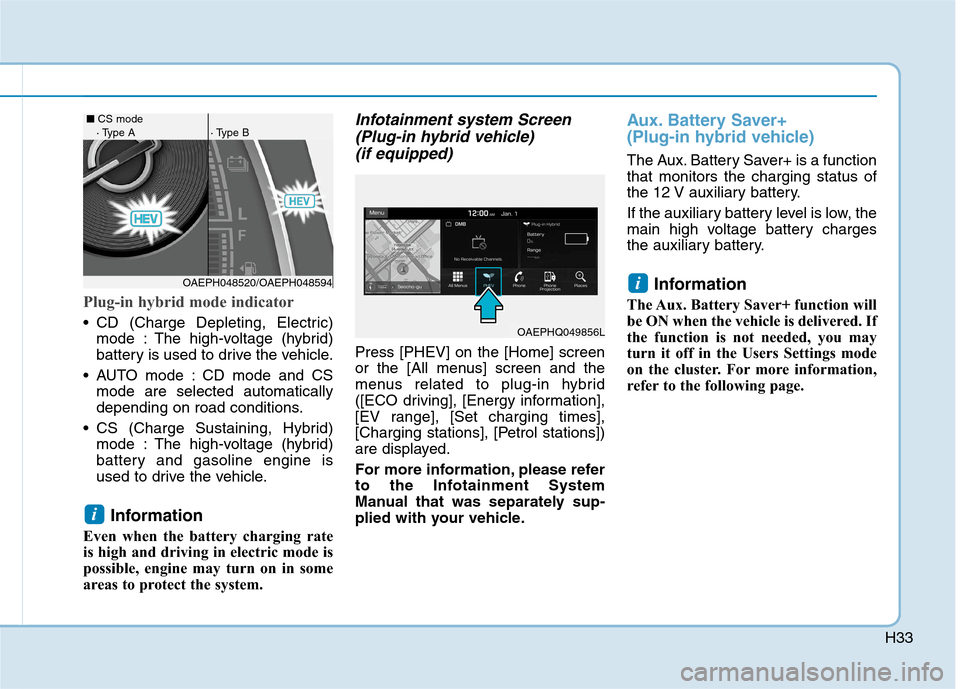
H33
Plug-in hybrid mode indicator
CD (Charge Depleting, Electric)
mode : The high-voltage (hybrid)
battery is used to drive the vehicle.
AUTO mode : CD mode and CS
mode are selected automatically
depending on road conditions.
CS (Charge Sustaining, Hybrid)
mode : The high-voltage (hybrid)
battery and gasoline engine is
used to drive the vehicle.
Information
Even when the battery charging rate
is high and driving in electric mode is
possible, engine may turn on in some
areas to protect the system.
Infotainment system Screen
(Plug-in hybrid vehicle)
(if equipped)
Press [PHEV] on the [Home] screen
or the [All menus] screen and the
menus related to plug-in hybrid
([ECO driving], [Energy information],
[EV range], [Set charging times],
[Charging stations], [Petrol stations])
are displayed.
For more information, please refer
to the Infotainment System
Manual that was separately sup-
plied with your vehicle.
Aux. Battery Saver+
(Plug-in hybrid vehicle)
The Aux. Battery Saver+ is a function
that monitors the charging status of
the 12 V auxiliary battery.
If the auxiliary battery level is low, the
main high voltage battery charges
the auxiliary battery.
Information
The Aux. Battery Saver+ function will
be ON when the vehicle is delivered. If
the function is not needed, you may
turn it off in the Users Settings mode
on the cluster. For more information,
refer to the following page.
i
i
■CS mode
· Type A · Type B
OAEPH048520/OAEPH048594
OAEPHQ049856L
Page 606 of 635
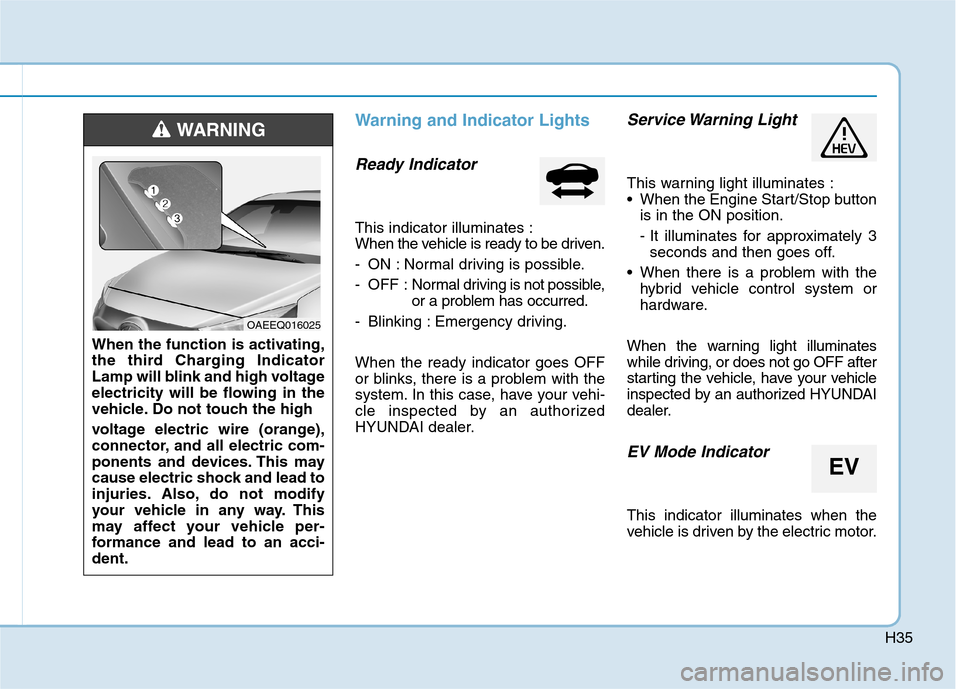
H35
Warning and Indicator Lights
Ready Indicator
This indicator illuminates :
When the vehicle is ready to be driven.
- ON : Normal driving is possible.
- OFF : Normal driving is not possible,
or a problem has occurred.
- Blinking : Emergency driving.
When the ready indicator goes OFF
or blinks, there is a problem with the
system. In this case, have your vehi-
cle inspected by an authorized
HYUNDAI dealer.
Service Warning Light
This warning light illuminates :
When the Engine Start/Stop button
is in the ON position.
- It illuminates for approximately 3
seconds and then goes off.
When there is a problem with the
hybrid vehicle control system or
hardware.
When the warning light illuminates
while driving, or does not go OFF after
starting the vehicle, have your vehicle
inspected by an authorized HYUNDAI
dealer.
EV Mode Indicator
This indicator illuminates when the
vehicle is driven by the electric motor. When the function is activating,
the third Charging Indicator
Lamp will blink and high voltage
electricity will be flowing in the
vehicle. Do not touch the high
voltage electric wire (orange),
connector, and all electric com-
ponents and devices. This may
cause electric shock and lead to
injuries. Also, do not modify
your vehicle in any way. This
may affect your vehicle per-
formance and lead to an acci-
dent.
WARNING
OAEEQ016025
EV
Page 632 of 635
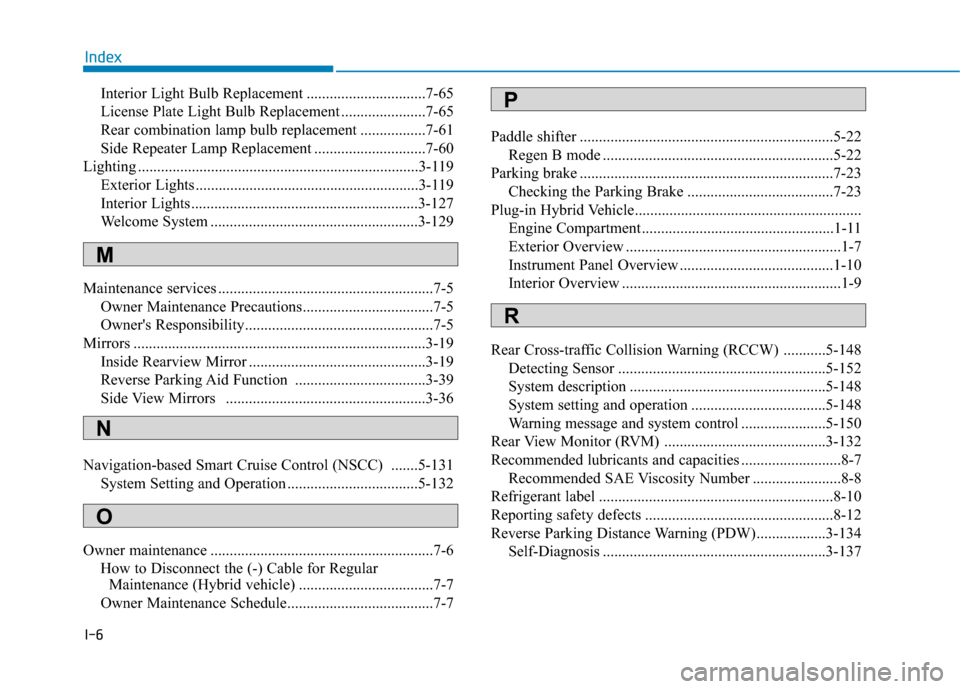
I-6
Interior Light Bulb Replacement ...............................7-65
License Plate Light Bulb Replacement ......................7-65
Rear combination lamp bulb replacement .................7-61
Side Repeater Lamp Replacement .............................7-60
Lighting .........................................................................3-119
Exterior Lights ..........................................................3-119
Interior Lights...........................................................3-127
Welcome System ......................................................3-129
Maintenance services ........................................................7-5
Owner Maintenance Precautions..................................7-5
Owner's Responsibility.................................................7-5
Mirrors ............................................................................3-19
Inside Rearview Mirror ..............................................3-19
Reverse Parking Aid Function ..................................3-39
Side View Mirrors ....................................................3-36
Navigation-based Smart Cruise Control (NSCC) .......5-131
System Setting and Operation ..................................5-132
Owner maintenance ..........................................................7-6
How to Disconnect the (-) Cable for Regular
Maintenance (Hybrid vehicle) ...................................7-7
Owner Maintenance Schedule......................................7-7Paddle shifter ..................................................................5-22
Regen B mode ............................................................5-22
Parking brake ..................................................................7-23
Checking the Parking Brake ......................................7-23
Plug-in Hybrid Vehicle...........................................................
Engine Compartment ..................................................1-11
Exterior Overview ........................................................1-7
Instrument Panel Overview ........................................1-10
Interior Overview .........................................................1-9
Rear Cross-traffic Collision Warning (RCCW) ...........5-148
Detecting Sensor ......................................................5-152
System description ...................................................5-148
System setting and operation ...................................5-148
Warning message and system control ......................5-150
Rear View Monitor (RVM) ..........................................3-132
Recommended lubricants and capacities ..........................8-7
Recommended SAE Viscosity Number .......................8-8
Refrigerant label .............................................................8-10
Reporting safety defects .................................................8-12
Reverse Parking Distance Warning (PDW)..................3-134
Self-Diagnosis ..........................................................3-137
Index
O
M
N
P
R
Page 634 of 635
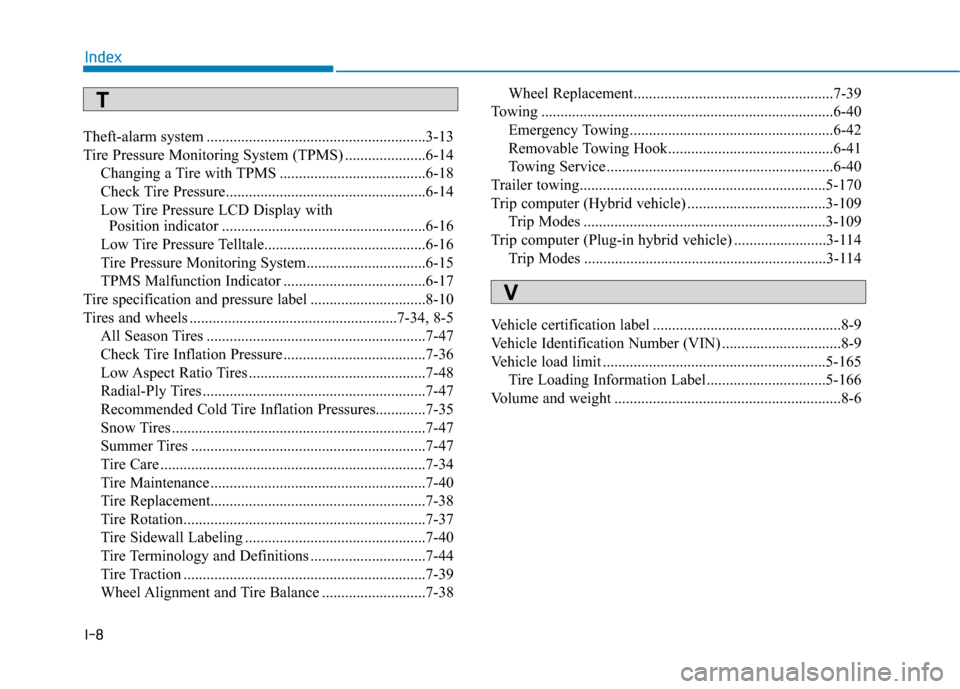
I-8
Theft-alarm system .........................................................3-13
Tire Pressure Monitoring System (TPMS) .....................6-14
Changing a Tire with TPMS ......................................6-18
Check Tire Pressure....................................................6-14
Low Tire Pressure LCD Display with
Position indicator .....................................................6-16
Low Tire Pressure Telltale..........................................6-16
Tire Pressure Monitoring System...............................6-15
TPMS Malfunction Indicator .....................................6-17
Tire specification and pressure label ..............................8-10
Tires and wheels ......................................................7-34, 8-5
All Season Tires .........................................................7-47
Check Tire Inflation Pressure .....................................7-36
Low Aspect Ratio Tires ..............................................7-48
Radial-Ply Tires ..........................................................7-47
Recommended Cold Tire Inflation Pressures.............7-35
Snow Tires ..................................................................7-47
Summer Tires .............................................................7-47
Tire Care .....................................................................7-34
Tire Maintenance ........................................................7-40
Tire Replacement........................................................7-38
Tire Rotation...............................................................7-37
Tire Sidewall Labeling ...............................................7-40
Tire Terminology and Definitions ..............................7-44
Tire Traction ...............................................................7-39
Wheel Alignment and Tire Balance ...........................7-38Wheel Replacement....................................................7-39
Towing ............................................................................6-40
Emergency Towing.....................................................6-42
Removable Towing Hook...........................................6-41
Towing Service ...........................................................6-40
Trailer towing................................................................5-170
Trip computer (Hybrid vehicle) ....................................3-109
Trip Modes ...............................................................3-109
Trip computer (Plug-in hybrid vehicle) ........................3-114
Trip Modes ...............................................................3-114
Vehicle certification label .................................................8-9
Vehicle Identification Number (VIN) ...............................8-9
Vehicle load limit ..........................................................5-165
Tire Loading Information Label...............................5-166
Volume and weight ...........................................................8-6
Index
T
V